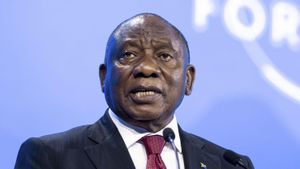The Trump administration's recent decision to impose tariffs on imports from Canada, Mexico, and China is echoing through global markets, raising fears of economic repercussions reminiscent of historical protectionist measures.
According to Bloomberg, President Trump's tariff plan, which includes general tariffs of 25% on both Canada and Mexico and 10% on China, is set to create significant turmoil across international trade. Economists worry about the consequences this move could have on economic stability.
Notably, as the announcements rolled out, China's manufacturing activity saw an unexpected decline. The Caixin manufacturing purchasing managers index dropped to 50.1, the lowest it has been since last September, indicating signs of contraction rather than growth. Senior economist at Caixin Insight Group, Wang Zhe, commented, "The major challenges stemmed from a notable drop in employment, sluggish external demand and weak price levels." This dip aligns with what many analysts predicted as the immediate effects of the tariffs began to materialize, complicate the recovery of what's already been a struggling economy.
One area most impacted was China's exports, which historically have been buoyed by manufacturing strength and global demand. Following Trump's announcement, uncertainty looms large, leading economists to assert this could result in deteriorated export conditions for China, exacerbated by the decline of their manufacturing sector.
Meanwhile, the response from global markets was swift. The dollar surged, reflecting traders' fears and expectations surrounding inflation and economic growth forecasts. Stock markets across the U.S. and Europe plummeted, with the S&P's reaction indicating unease over increased price pressures due to the tariffs. The Nasdaq Golden Dragon Index, which tracks Chinese companies listed overseas, fell 3.5%, its worst day since before the weekend.
Steven Englander, global head of G-10 FX research at Standard Chartered, succinctly described the market's sentiment, stating, "He seems to be like a poker player who’s betting his whole stash on the first hand. The market just wasn’t prepared for it." The speculative nature of the tariffs, he suggests, caught traders off guard and sowed uncertainty about future economic conditions.
The potential for retaliatory tariffs from affected countries like Canada and Mexico only adds to this uncertainty. Both nations have already hinted at implementing countermeasures, leading to fears of escalation. The prospect of engaging in tariff disputes not only threatens to harm specific sectors such as agriculture and manufacturing but also carries broader risks for the U.S. economy, particularly as around 30% of S&P 500 profits stem from foreign revenue.
Meanwhile, historical perspectives on tariffs paint troubling pictures of potential outcomes. Past enactments of similar acts, most notoriously the Smoot-Hawley Tariff Act during the Great Depression, demonstrate how such policies can lead to tit-for-tat measures, drastically disrupting international trade and precipitating economic decline.
Dr. Desmond Lachman of the American Enterprise Institute reflected on this history, noting, "If there is one thing we should have learned from the Smoot-Hawley tariff experience, it’s how damaging trade wars can be for the global economy." He warns against the impending economic hardships these tariffs could catalyze, particularly at such fragile times for economies around the world.
Trump's current trade policies, which focus on revitalizing domestic manufacturing and reducing trade deficits, may counterintuitively achieve the opposite if they provoke widespread economic retaliation. Analysts indicate these precautionary tariff measures are likely to inflate consumer prices. With rising import costs impacting everyday goods, inflation could thwart any efforts to cut interest rates, complicate Federal Reserve strategies, and eventually exacerbate budget deficits projected to swell alongside tax cuts.
China, for its part, has vowed to respond decisively. The government has announced it will pursue action through the World Trade Organization and indicated readiness to implement countermeasures against U.S. sectors reliant on exports.
With Chinese manufacturing already under pressure and fears of recession looming large, the global economic fallout of Trump’s tariff actions remains unpredictable. It’s clear, as more details emerge, all eyes will be on how these policies play out—both at home and across international markets.
Looking forward, observers are cautioning against complacency. The trade tensions initiated by Trump's administration could shape economic trajectories worldwide. Many hope for resolution but recognize the need for proactive measures to mitigate the potential damages set to ripple across economies.



